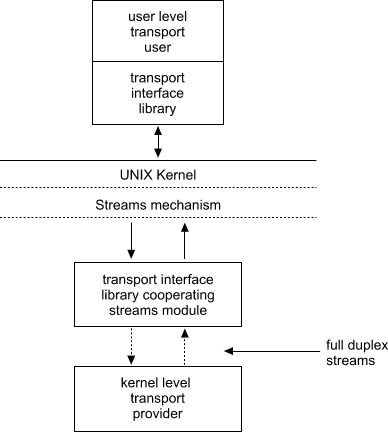
|
|
TPI defines a message interface to a transport provider implemented under STREAMS. A user communicates to a transport provider via a full duplex path known as a stream; see the following illustration. This stream provides a mechanism in which messages may be passed to the transport provider from the transport user and vice versa.

Example of a Stream from a User to a Transport Provider
The STREAMS messages that are used to communicate transport service primitives between the transport user and the transport provider may have one of the following formats:
Intro(D7str) contains descriptions of the transport primitives which define both a connection-mode and connectionless-mode transport service. There are also primitives that pertain to both transport modes.
For each type of transport service, two types of primitives exist:
The primitives which originate from the transport user make requests to the transport provider or respond to an event of the transport provider.
The primitives which originate from the transport provider are either confirmations of a request or are indications to the transport user that an event has occurred.
``Mapping Of Transport Primitives to OSI'' lists the primitive types along with the mapping of those primitives to the STREAMS message types and the transport primitives of the ISO IS 8072 and IS 8072/DAD transport service definitions. The format of these primitives and the rules governing the use of them are described in ``Allowable Sequence of TPI Primitives''.